As the arrival of spring brings warmer temperatures across Britain, wildlife experts are encouraging gardeners to leave out pet food and water to help hedgehogs and dormice safely emerge from hibernation. These small mammals, which have spent the winter in sheds, log piles, compost heaps, and under hedgerows, wake up feeling weak, disoriented, and in need of food to replenish their energy levels.
According to GardenBuildingsDirect.co.uk, many hibernating animals begin stirring in March and April, though their activity depends on weather conditions. After months of deep sleep, hedgehogs and dormice emerge into a world that may feel unfamiliar. Their body temperature and metabolism need time to regulate, and without an immediate food source, they can struggle to recover from the long winter.
Wildlife experts are urging the public to take simple but effective steps to support these creatures during this vulnerable time. Leaving out a small bowl of meaty cat or dog biscuits can provide a much-needed energy boost, while a shallow dish of fresh water will help with hydration.
These small gestures can make a critical difference in their survival, particularly in urban areas where natural food sources may not be immediately available.
In addition to providing food and water, experts emphasize the importance of creating safe exit routes for animals leaving hibernation.
Many hedgehogs and dormice have chosen to spend the winter in enclosed spaces such as sheds, summerhouses, or even inside piles of garden waste. When they wake, they may find themselves trapped or unable to navigate their surroundings.
Gardeners are encouraged to leave shed and summerhouse doors open overnight, allowing the animals to leave on their own when they are ready. Creating small gaps in fences and hedgerows can also provide a safe passage for them to move freely between gardens in search of food.
By ensuring they have access to a larger area, their chances of finding natural food sources such as insects, berries, and fallen fruit increase significantly.
While leaving out pet food is a great short-term solution, a longer-term approach involves making gardens more wildlife-friendly.
Experts recommend planting native species that attract insects, which in turn serve as a natural food supply for hedgehogs and other small creatures emerging from hibernation. Allowing parts of the garden to remain untamed, with log piles and leaf litter, can also help provide shelter and encourage a thriving ecosystem.
Hedgehogs, in particular, can appear wobbly and unsteady when they first wake from hibernation, but this is a normal part of the process as their bodies adjust to the warmer temperatures.
However, if a hedgehog or dormouse appears lethargic, underweight, or visibly injured, experts advise contacting a wildlife rescue centre for assistance. Animals that have struggled to maintain body fat over the winter may require additional care before they are strong enough to fend for themselves.
A spokesperson for GardenBuildingsDirect.co.uk highlighted the importance of giving these creatures the best possible start to spring.
“If you’ve had a winter visitor in your garden, shed, or compost heap, now is the time to think about how you can help. Leaving food, water, and an easy exit route can make all the difference. These small steps allow hedgehogs and dormice to regain strength and transition back into the wild safely.”

